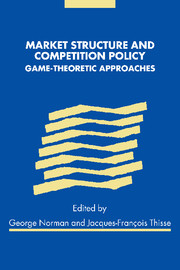Book contents
- Frontmatter
- Contents
- List of figures
- List of tables
- List of contributors
- Louis Phlips: a brief biography
- Introduction
- 1 Competition policy and game-theory: reflections based on the cement industry case
- 2 Legal standards and economic analysis of collusion in EC competition policy
- 3 A guided tour of the Folk Theorem
- 4 Predatory pricing and anti-dumping
- 5 Should pricing policies be regulated when firms may tacitly collude?
- 6 Tougher price competition or lower concentration: a trade-off for anti-trust authorities?
- 7 The strategic effects of supply guarantees: the raincheck game
- 8 Product market competition policy and technological performance
- 9 On some issues in the theory of competition in regulated markets
- 10 Modelling the entry and exit process in dynamic competition: an introduction to repeated-commitment models
- 11 Coordination failures in the Cournot approach to deregulated bank competition
- 12 How the adoption of a new technology is affected by the interaction between labour and product markets
- Index
3 - A guided tour of the Folk Theorem
Published online by Cambridge University Press: 22 September 2009
- Frontmatter
- Contents
- List of figures
- List of tables
- List of contributors
- Louis Phlips: a brief biography
- Introduction
- 1 Competition policy and game-theory: reflections based on the cement industry case
- 2 Legal standards and economic analysis of collusion in EC competition policy
- 3 A guided tour of the Folk Theorem
- 4 Predatory pricing and anti-dumping
- 5 Should pricing policies be regulated when firms may tacitly collude?
- 6 Tougher price competition or lower concentration: a trade-off for anti-trust authorities?
- 7 The strategic effects of supply guarantees: the raincheck game
- 8 Product market competition policy and technological performance
- 9 On some issues in the theory of competition in regulated markets
- 10 Modelling the entry and exit process in dynamic competition: an introduction to repeated-commitment models
- 11 Coordination failures in the Cournot approach to deregulated bank competition
- 12 How the adoption of a new technology is affected by the interaction between labour and product markets
- Index
Summary
Introduction
The Folk Theorem suggests the possibility of cooperation through a self-enforcing agreement. The phrase ‘Folk Theorem for repeated games’ refers strictly to a theorem stating that a certain large class of single-shot game payoffs can be obtained as Nash equilibrium payoffs if the game is repeated infinitely many times and the players do not discount their payoffs (Aumann, 1960). It refers more broadly to similar results, supported by subgame perfect equilibria (SPEs), for games that are finitely repeated and infinitely repeated games in which players may discount payoffs. Perhaps the most striking implication of these results is the possibility of apparently cooperative outcomes in non-cooperative games when these games are knowingly played many times by a fixed collection of players.
I have been aware of, and impressed by, the work of Louis Phlips for about a quarter of a century. His work on competition policy is meticulous and distinguished. The topic of my contribution bears on competition policy, because the Folk Theorem literature spells out means by which firms can attain outcomes that appear collusive without, necessarily, engaging in overt collusion – or, indeed, even discussing together what to do.
Infinite horizon oligopoly is a well known example of a repeated game. The Cournot model is the most widely taught example and it is typical in that the Cournot equilibrium (i.e. the Nash equilibrium of the single-shot Cournot market) generally results in a payoff profile that lies inside the payoff possibility frontier.
- Type
- Chapter
- Information
- Market Structure and Competition PolicyGame-Theoretic Approaches, pp. 51 - 69Publisher: Cambridge University PressPrint publication year: 2000
- 1
- Cited by



